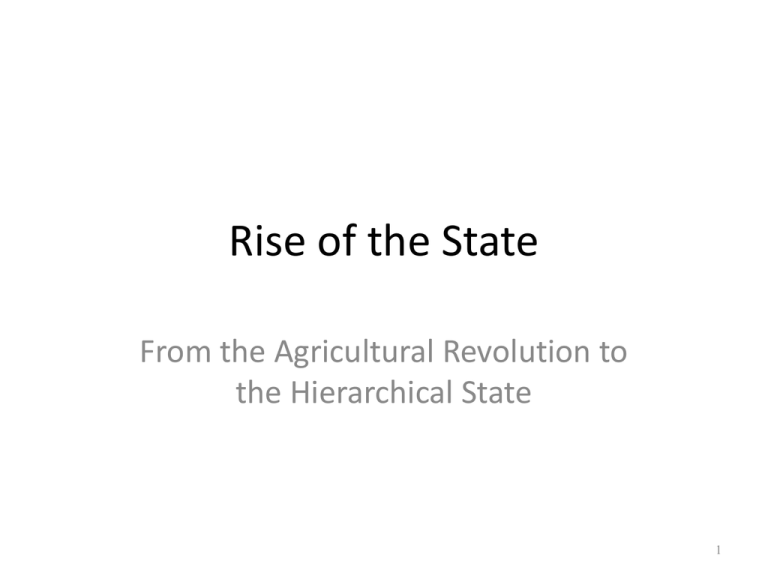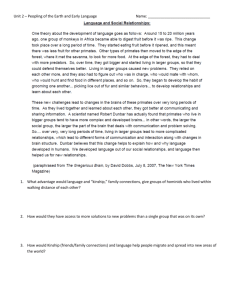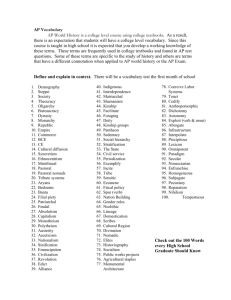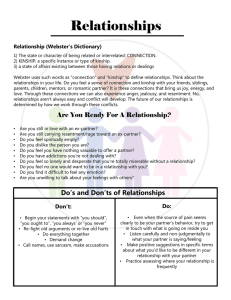Feb 9
advertisement

Rise of the State From the Agricultural Revolution to the Hierarchical State 1 Outline • 1) Hierarchical state society in art: the stele of Hammurabi’s code • 2) Two theories of history: L or U? • 3) What caused the agricultural revolution? – Stages • 4) What caused the rise of the state? 2 3 4 Two works of art • Compare the artworks: – Hunter-gatherers – Civilization • How do these works express the differences in the outlooks of the people? – Relation to nature? – Relation between people? – Beliefs, ideas about life? 5 Shamash and Hammurabi • Which is which? (Spodek, 59) • Gods look like kings (and vice versa) – Anthropocentric or regicentric? • Separation of ruler from ruled • Separation of divine from human • God-given laws cement human divisions – Rich and poor – Men and women 6 Threefold approach to society • • • • Relation to nature – technology Relation between people – social structure Belief system – form of consciousness Harmony between these levels (normally) 7 Historical “fall” (summary) • On technological level – from dependence on independent nature – to control over nature • On social level – from family-based, egalitarian society – to class-based, male dominant society – rulers are all powerful • On consciousness level – Animist oneness > Gods/priests are all powerful 8 L Theory of History • 110,000 years of kinship society • 5,500 years of “civilization” – Growing technology – Increasing social inequality – Plus growing environmental destruction 9 U theory of history • 190,000 to 110,000 years of kinship society with primitive technology • 5,500 years of inequality and oppression – But also, creation of advanced technology • Future: global kinship with advanced technology 10 End of “civilization”? • Social changes: Growth of democracy, equality – Continued inequalities or new equality? – Political rights for free men: 240 years old (American revolution) – Civil rights for slaves: 151 years old (Civil War) – Political rights for women: 96 years old (Women’s right to vote, 19th Amendment, 1920); – end of segregation in the US south: 51 years old (Voting Rights Act of 1965)? 11 New global kinship? • Nature, technology and consciousness – Continued domination over nature or – New ecology movement > consciousness of our oneness with nature, with the earth (film “Avatar”) • Tech: Transportation and communications: one world family (global kinship) – Or are we now slaves to the Internet? 12 What caused the agricultural revolution? • 1) Discovery of new technology? • 2) Population increase? • 3) Climate change? 13 Explanations: why agriculture? • (1) New technology, discovery? • What did women gatherers know? • How much work is needed? (Spodek, 43) – Hunter gatherers: 800-1000 hours – Agriculturalists:1000-1300 hours • Which work is harder? • Who is healthier? 14 (2) Population increase? • H-G: 0.4 sq km: 9 people (S., 41) – Bands of 25 people each, loosely related > 500 in exogamous tribe (Spodek, 26-7) • Agriculture: 200-400 people for the same area • Biology of reproduction – Lactating H-G mothers carrying infants up to four years – Sedentary agricultural mothers 15 (3) Climate change • Ending of last ice age 15,000 years ago (S, 41) – plains > forests – = dwindling of ecology of great herds – Plus: hunting continues as before – > Ecological disaster 16 Difference between Eurasia-Africa and the Americas • In Americas: – Early extinction of domestic animals: cattle, sheep, horses, pigs – Why no wheel in “New World”? – What caused defeat of Aztecs, Incas, by Cortes, European invaders? – Technological lag? Vulnerability to European diseases? • In Eurasian/African land mass – Larger land mass – New technologies developed before extinctions 17 Paradox of Paleolithic ecological catastrophe • Respect for nature of early animistic peoples – Descent into caves, rituals for renewing animal, plant species (magic) • >Destruction of nature – New circumstances (climate change, global warming) – Hunter/gatherers didn’t know what they were doing – Gilgamesh & Enkidu kill the Humbaba (spirit guaardian of the forest) (See film Princess Mononoke) 18 Is technological “control” bad for nature? • What saved animal species in Old World? – More time for changes to take place in larger territory – Agricultural-herding (neolithic) revolutions: herders, agriculturalists produce their own means of survival • = interpenetration, humanization of nature – From magic to practical activity – New technology creates possibility of a new, more real sense of harmony with nature – But this did not happen. Why not? 19 Civilization: break with nature • • • • • • • • • • Many things cause terror and wonder, yet nothing is more terrifying and wonderful than man. This thing goes across the gray sea on the blasts of winter storms, passing beneath waters towering 'round him. The Earth, eldest of the gods, unwithering and untiring, this thing wears down as his plows go back and forth year after year furrowing her with the issue of horses. (Antigone, 332-41) 20 So why the passage in Antigone? • Sense of violation of Nature – Break from religion of nature – Sense of guilt and pride • But not the result of technology per se – Technology can save nature • So: need to consider the new social factor: hierarchical state, division of rich and poor, master and slave – Control of people over people > break from, control over nature – What people do to animals and the natural world, they first do to each other 21 Stages in agricultural revolution • 1) Slash-and-burn (10,000 BCE) • 2) Early hoe agriculture on flood plains – Tigris and Euphrates – Nile • 3) Hierarchical irrigation state 3000 BCE • 4) Iron plow agriculture on rain-watered lands (1000 BC . . . ) • 5) Next stage: 500 CE in Europe ?? 22 Slash and burn agriculture • • • • Cooperative social relations Hoe agriculture, women’s work Use of ash -- limitations Nomadic way of life continues – Life is difficult • Today: Brazil – Amazon rain forests 23 Flood plains of great rivers • Simple tools (hoe) • Natural, regular fertilization of soil by flooding rivers • Abundant harvest –> surplus of grain – Stored in granaries – Life is easy (easier) • Social level: Continuation of ancient cooperative kinship system 24 Hymn to the Nile • Praise to thee, O Nile, that issueth from the earth, and cometh to nourish Egypt. . . . • That maketh barley and createth wheat, so that he may cause the temples to keep festivals. . . . • If he be sluggish . . . millions of men perish. • Offer is made to every other god as is done for the Nile . . . 25 Location of Garden of Eden • “And the Lord God planted a garden eastward in Eden. . . . And the fourth river is Euphrates.” Genesis 2:8 • From slash-and-burn poverty to abundance of paradise? 26 What caused the “fall”? • Rise of the hierarchical state – 1) requirements of large populations? – 2) military necessity? – 3) requirements for organizing irrigation systems? – 4) exploitation of the majority by a minority? 27 1) Large Populations without States • Difficulties of uniting different kinship societies. But not impossible • Hunter-gatherer assemblies of local groups • Tiv people in Africa united 1 million • Iroquois Federation united separate tribes • Hence: large populations can be organized without a “state” 28 2) Military necessity? • 1) Traditional system of military: armed men of the kinship group – American Indian military power: not separate army • 2) “State” = military power over the people (Gilgamesh) • Hence: defense is possible without a “state” 29 3) Social problems of organizing irrigation • Separate villages multiply along river • Population growth > move away from river • > need for cooperation between kinship groups • It is possible to have cooperation without a “state” – Iroquois voluntary union of five nations – Maintains democratic constitution 30 Problems with Kinship Groups • First stage of history: kinship groups • Basic problems of this stage – Separation of groups – Sporadic wars • Second stage: uniting of separate kinship groups – Growing populations – More frequent interaction, conflicts • Two methods of unification – cooperation – force: hierarchical state • Hence: a choice between two methods 31 4) Exploitation of surplus • 1) Production of surplus – based on higher productivity of simple labor – Due to natural fertility of flooding river • 2) Surplus as target – From the outside > military protection needed – From within the village > from the military protectors themselves • 3) Chief chosen by people > rules over them 32 Rise of the hierarchical state • 1) Traditional system of community control – Military leader is subordinate to community – Iroquois: women elders in charge • 2) Conquest of the community – From within the community: the military leader seizes control, overthrows the old kinship order (Legal state of the West—positive law replaces kinship traditions) – From outside the community: another kinship community takes over, conquers the first (neo-kinship state of the East) 33 State as System of Inequality • • • • • State as class-divided, hierarchy Power in hands of a few Standing army under rule of elite Women subordinate to men Slavery 34







